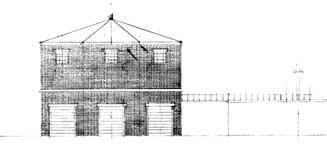After leaving the soil from the sumac plants, the water is filtered by a rudimentary still. This model of the Norwalk Waste Treatment Facility works according to guidelines laid out in the U.S. Army's survival training manual for distilling fresh water from humus. The Norwalk facility uses sunlight to generate heat in massive transparent holding tanks, which causes pure water to evaporate out of the sewage and be collected and returned to the general supply. The accumulated sludge is periodically collected and distributed as fertilizer to local farms. Actually, the waste that leaves the gallery is sent in large part directly into the East River. There is a 19-foot diameter pipe which terminates at Fulton Street just below that big ship. All manner of debris pours from this orifice year round. This effluent is supposedly the overflow from a treatment plant on Carmine Street (the address of which is strangely the same as that of a public swimming pool), but there are no documents or city bureaus that can verify the information.
The New York Drain Commissioner's office is concerned mainly with blockages in the sewers which cause flooding in the streets and the lower levels of some buildings. According to the office, around half of the sewers in New York are more than one hundred years old, and are not reliably mapped. Apparently, no one really knows where most of the liquid municipal waste in the city goes. Approximately every other summer, hospital waste washes up on the beaches of Long Island. This toxic debris is presumed to have been dumped into the Atlantic Ocean by unscrupulous carting companies, but recent studies of the material impounded after these events has revealed that much of it is over 40 years old. The filtered water discharged by the model is distributed in part back to the reservoir, and the rest of it goes somewhere else.
